International Journal of Intelligent Systems and Applications @ijisa
Статьи журнала - International Journal of Intelligent Systems and Applications
Все статьи: 1203
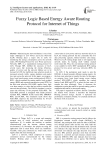
Fuzzy logic based energy aware routing protocol for internet of things
Статья научная
Maximizing the network lifetime is one of the major challenges in Low Power and Lossy Networks (LLN). Routing plays a major role in LLN, for minimizing the energy consumption across the network nodes. IPv6 Routing Protocol for Low Power and Lossy Networks (RPL) is a standardized routing protocol for LLN. Though, RPL fulfilled the necessity of LLN, several issues like increasing the energy efficiency, quality of service and the network lifetime are to be focused. In LNN, the inefficient route selection results in increased network traffic, energy depletion and packet loss ratio across the network. In this paper, we propose a fuzzy logic based energy aware routing protocol (FLEA-RPL), which considers the routing metrics load, residual energy (RER) and expected transmission count (ETX) for the best route selection. FLEA-RPL applies fuzzy logic over these metrics, to select the best route to transfer the network data efficiently. The COOJA simulator is used to assess the efficiency of the proposed FLEA-RPL. The FLEA-RPL protocol is compared with similar protocol standard RPL, MRHOF (ETX) based RPL (MRHOF-RPL) and FL-RPL. The simulation result shows that FLEA-RPL improves the network lifetime by 10-12% and packet delivery ratio by 2-5%.
Бесплатно
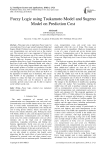
Fuzzy logic using tsukamoto model and sugeno model on prediction cost
Статья научная
This paper aims to implement Fuzzy Logic for cost prediction. Fuzzy Logic using Tsukamoto Model and Sugeno Model. Predicted costs consist of communication cost, transportation cost, and social cost as the external cost. The external cost is one component of living cost. High external cost becomes one of the causes of the high cost of living. The high cost of living is one of the factors causing high-cost economy. In this case, the cost prediction using Fuzzy Logic. Experimental results show that Fuzzy Logic using Tsukamoto Model with value is 1891. Fuzzy Logic using Sugeno Model with value 1621. Both models produce a feasible cost prediction. Feasible is meaning accurate and proper (value cost between low cost and high cost from all of cost). There are 46.56 % of the population of middle class in Indonesia. This means that 46.56% of the population of Indonesia has the potential to reduce the high cost economy. High cost economy (living cost) can be reduced, it can drive economic growth (social cost) and be able to improve social welfare (social cost).
Бесплатно
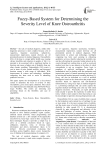
Fuzzy-Based System for Determining the Severity Level of Knee Osteoarthritis
Статья научная
The task of medical diagnosis, unlike other diagnostic processes is more complex because a lot of vagueness, linguistic uncertainty, subjectivity, measurement imprecision, natural diversity are all prominently present in medical diagnosis. Osteoarthritis (OA) of the knee is a major public health issue causing chronic disability and reduction in quality of life; it is reported to be associated with a significant decline in function and causes a higher rate of disability than any other chronic condition. Osteoarthritis (OA) exacts a cost in terms of pain, limited mobility, and decreased function among a wide range of individuals. With improvement in science and technology, intelligent computing has been used to assist in enhancing qualitative services. This paper reports the development of a fuzzy-based system to determine the level of severity of knee osteoarthritis, given some input conditions. The system was implemented and simulated using MATLAB Fuzzy Logic Toolbox. The results are entrusting and promising based on the flexibility and case of adaptability.
Бесплатно
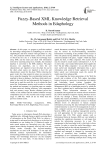
Fuzzy-Based XML Knowledge Retrieval Methods in Edaphology
Статья научная
In this paper, we propose a proficient method for knowledge management in Edaphology to assist the edaphologists and those related with agriculture in a big way. The proposed method mainly consists two sections of which the first one is to build the knowledge base using XML and the latter part deals with information retrieval by searching using fuzzy. Initially, the relational database is converted to the XML database. The paper discusses two algorithms, one is when the soil characteristics are inputted to have the plant list and in the other, plant names are inputted to have the soil characteristics suited for the plant. While retrieving the query result, the crisp numerical values are converted to fuzzy using the triangular fuzzy membership function and matched to those in database. And those which satisfy are added to the result list and subsequently the frequency is found out to rank the result list so as to obtain the final sorted list. Performance metrics used in order to evaluate the method and compare it to baseline paper are number of plants retrieved, ranking efficiency, and computation time and memory usage. Results obtained proved the validity of the method and the method obtained average computation time of 0.102 seconds and average memory usage of 2486 Kb, which all are far better than the previous method results.
Бесплатно
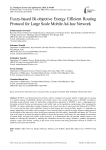
Fuzzy-based Bi-objective Energy Efficient Routing Protocol for Large Scale Mobile Ad-hoc Network
Статья научная
MANET is an infrastructure-less network, which is comprised of a greater number of nodes that are moving in a random manner. Establishing efficient and reliable routes is the crucial design issue in MANET. In addition, providing energy-efficient routes for performing communication operations in MANET is also a challenging goal. Increasing network lifetime and decreasing overall traffic load are the significant considerations while designing the MANET. An energy optimization routing mechanism with a fuzzy basis that is state-based and influenced by COVID-19 is used to prevent and control epidemics. Based on their lifespan and varying mobility speeds, it is dependent on energy optimization yield under various scenarios. Fuzzy-based bi-objective criteria in energy-efficient routing protocol for the mobile ad-hoc network to select the different constraints like link stability, bandwidth, and battery life. The main goal of this paper is to obtain the optimal solution to choose the best route, limit battery life, and change the movement of mobile nodes for large-scale mobile ad-hoc networks. It is demonstrated that the possible solution relates to the domain of selecting the variables by outlining the connection between the energy function’s variables. Researchers optimize a path's link lifespan, resulting in the choice of the shortest path being particularly efficient in COVID-19 pandemic prevention and treatment.
Бесплатно
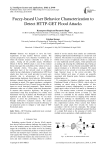
Fuzzy-based user behavior characterization to detect HTTP-GET flood attacks
Статья научная
Internet was designed to serve the basic requirement of data transfer between systems. The security perspectives were therefore overlooked due to which the Internet remains vulnerable to a variety of attacks. Among all the possible attacks, Distributed Denial of Service (DDoS) attack is one of the eminent threats that target the availability of the online services to the intended clients. Now-a-days, attackers target application layer of the network stack to orchestrate attacks having a high degree of sophistication. GET flood attacks have been very much prevalent in recent years primarily due to advancement of bots allowing impersonating legitimate client behavior. Differentiating between a human client and a bot is therefore necessary to mitigate an attack. This paper introduces a mitigation framework based on Fuzzy Control System that takes as input two novel detection parameters. These detection parameters make use of clients' behavioral characteristic to measure their respective legitimacy. We design an experimental setup that incorporates two widely used benchmark web logs (Clarknet and WorldCup) to build legitimate and attack datasets. Further, we use these datasets to assess the performance of the proposed through well-known evaluation metrics. The results obtained during this work point towards the efficiency of our proposed system to mitigate a wide range of GET flood attack types.
Бесплатно
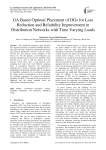
Статья научная
The distributed generation (DG) locations have significant impacts on network reliability and loss. This paper presents a method for optimal DG allocation and sizing in distribution systems in order to reduce network loss and improve system reliability at the lowest cost. For this purpose, a multi-objective cost function considering active power loss, reliability index and DG cost is used to find the optimal size and location of DG units. Also, a load duration curve including four load levels with different weighting factor is considered. Moreover, the optimization technique that is based on Genetic Algorithm (GA) is implemented. In this paper, ECOST index is considered for reliability evaluation in the cost function and also, the effects system reconfiguration, is also considered for reliability assessment. To evaluate the proposed algorithm, the IEEE 33-bus and 69-bus test systems are employed and the results obtained reveal the effectiveness of proposed method.
Бесплатно
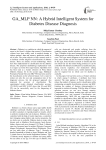
GA_MLP NN: A Hybrid Intelligent System for Diabetes Disease Diagnosis
Статья научная
Diabetes is a condition in which the amount of sugar in the blood is higher than normal. Classification systems have been widely used in medical domain to explore patient's data and extract a predictive model or set of rules. The prime objective of this research work is to facilitate a better diagnosis (classification) of diabetes disease. There are already several methodology which have been implemented on classification for the diabetes disease. The proposed methodology implemented work in 2 stages: (a) In the first stage Genetic Algorithm (GA) has been used as a feature selection on Pima Indian Diabetes Dataset. (b) In the second stage, Multilayer Perceptron Neural Network (MLP NN) has been used for the classification on the selected feature. GA is noted to reduce not only the cost and computation time of the diagnostic process, but the proposed approach also improved the accuracy of classification. The experimental results obtained classification accuracy (79.1304%) and ROC (0.842) show that GA and MLP NN can be successfully used for the diagnosing of diabetes disease.
Бесплатно
GPS based Advanced Vehicle Tracking and Vehicle Control System
Статья научная
Security systems and navigators have always been a necessity of human’s life. The developments of advanced electronics have brought revolutionary changes in these fields. In this paper, we will present a vehicle tracking system that employs a GPS module and a GSM modem to find the location of a vehicle and offers a range of control features. To complete the design successfully, a GPS unit, two relays, a GSM Modem and two MCU units are used. There are five features introduced in the project. The aim of this project is to remotely track a vehicle’s location, remotely switch ON and OFF the vehicle’s ignition system and remotely lock and unlock the doors of the vehicle. An SMS message is sent to the tracking system and the system responds to the users request by performing appropriate actions. Short text messages are assigned to each of these features. A webpage is specifically designed to view the vehicle’s location on Google maps. By using relay based control concept introduced in this paper, number of control features such as turning heater on/off, radio on/off etc. can be implemented in the same fashion.
Бесплатно
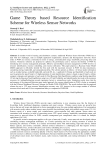
Game Theory based Resource Identification Scheme for Wireless Sensor Networks
Статья научная
In modern world of sensing and distributive systems, traditional Wireless Sensor Networks (WSN) has to deal with new challenges, such as multiple application requirements, dynamic and heterogeneous networks. Senor nodes in WSN are resource constrained in terms of energy, communication range, bandwidth, processing delay and memory. Numerous solutions are proposed to optimize the performance and to increase the lifetime of WSN by introducing new resource management principles. Effective and intelligent resource management in WSN involves in resource identification, resource scheduling, and resource utilization. This paper proposes a Bayesian Game Model (BGM) approach to efficiently identify the best node with the maximum resource in WSN for data transmission, considering energy, bandwidth, and computational delay. The scheme operates as follows: (1) Sensor nodes information such as residual energy, available bandwidth, and node ID, etc., is gathered (2) Energy and bandwidth of each node are used to generate the payoff matrix (3) Implementation of node identification scheme is based on payoff matrix, utilities assigned, strategies and reputation of each node (4) Find Bayesian Nash Equilibrium condition using Starring algorithm (5) Solving the Bayesian Nash Equilibrium using Law of Total Probability and identifying the best node with maximum resources (6) Adding/Subtracting reward (reputation factor) to winner/looser node. Simulation results show that the performance of the proposed Bayesian game model approach for resource identification in WSN is better as compared with the Efficient Neighbour Discovery Scheme for Mobile WSN (ENDWSN). The results indicate that the proposed scheme has up to 12% more resource identification accuracy rate, 10% increase in the average number of efficient resources discovered and 8% less computational delay as compared to ENDWSN.
Бесплатно
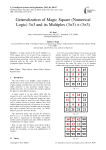
Generalization of Magic Square (Numerical Logic) 3×3 and its Multiples (3×3) × (3×3)
Статья научная
A magic square of 3×3 and its multiples i.e. (9×9) squares and so on, of order N are composed of (n×n) matrix having filled with numbers in such a way that the totals sum along the rows ,columns and main diagonals adds up the same. By using a special geometrical figure developed.
Бесплатно
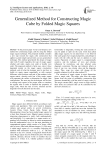
Generalized Method for Constructing Magic Cube by Folded Magic Squares
Статья научная
In the present paper we have developed a new method for constructing magic cube by using the folded magic square technique. The proposed method considers a new step towards the magic cube construction that applied a good insight and provides an easy generalized technique. This method generalized the design of magic cube with N order regardless the type of magic square whether odd order, singly even order or doubly even order. The proposed method is fairly easy, since it have depended mainly on the magic square construction methods, and all what the designer need is just how to builds six magic square sequentially or with constant difference value between each pair of the numbers in the square matrix, whereby each one of this magic square will represents the surface or dimension for magic cube configuration. The next step for the designer will be how to arrange each square in the proper order to constitute the regular cube in order to maintain the properties of magic cube, where the sum of rows, columns and the diagonals from all directions are the same.
Бесплатно
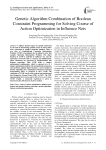
Статья научная
A military decision maker is typically confronted by the task of determining optimal course of action under some constraints in complex uncertain situation. Thus, a new class of Combinational Constraint Optimization Problem (CCOP) is formalized, that is utilized to solve this complex Operation Optimization Problem. The object function of CCOP is modeled by Influence net, and the constraints of CCOP relate to resource and collaboration. These constraints are expressed by Pseudo-Boolean and Boolean constraints. Thus CCOP holds a complex mathematical configuration, which is expressed as a 0 1 integer optimization problem with compositional constraints and unobvious optimal object function. A novel method of Genetic Algorithm (GA) combination of Boolean Constraint Programming (BCP) is proposed to solve CCOP. The constraints of CCOP can be easily reduced and transformed into Disjunctive Normal Form (DNF) by BCP. The DNF representation then can be used to drive GA so as to solve CCOP. Finally, a numerical experiment is given to demonstrate the effectiveness of above method.
Бесплатно
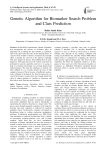
Genetic Algorithm for Biomarker Search Problem and Class Prediction
Статья научная
In the field of optimization, Genetic Algorithm that incorporates the process of evolution plays an important role in finding the best solution to a problem. One of the main tasks that arise in the medical field is to search a finite number of factors or features that actually affect or predict the survival of the patients especially with poor prognosis disease, thus helping them in early diagnosis. This paper discusses the various steps that are performed in genetic algorithm and how it is going to help in extracting knowledge out of high dimensional medical dataset. The more the attributes or features, the more difficult it is to correctly predict the class of that sample or instance. This is because of inefficient, useless, noisy attributes in the dataset. So, here the main aim is to search the features or genes that can strongly predict the class of subject (patient) i.e. healthy or cancerous and thus help in early detection and treatment.
Бесплатно
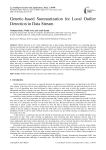
Genetic-based Summarization for Local Outlier Detection in Data Stream
Статья научная
Outlier detection is one of the important tasks in data mining. Detecting outliers over streaming data has become an important task in many applications, such as network analysis, fraud detections, and environment monitoring. One of the well-known outlier detection algorithms called Local Outlier Factor (LOF). However, the original LOF has many drawbacks that can’t be used with data streams: 1- it needs a lot of processing power (CPU) and large memory to detect the outliers. 2- it deals with static data which mean that in any change in data the LOF recalculates the outliers from the beginning on the whole data. These drawbacks make big challenges for existing outlier detection algorithms in terms of their accuracies when they are implemented in the streaming environment. In this paper, we propose a new algorithm called GSILOF that focuses on detecting outliers from data streams using genetics. GSILOF solve the problem of large memory needed as it has fixed memory bound. GSILOF has two phases. First, the summarization phase that tries to summarize the past data arrived. Second, the detection phase detects the outliers from the new arriving data. The summarization phase uses a genetic algorithm to try to find the subset of points that can represent the whole original set. our experiments have been done over real datasets. Our experiments confirming the effectiveness of the proposed approach and the high quality of approximate solutions in a set of real-world streaming data.
Бесплатно
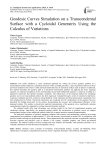
Статья научная
This article introduces a novel variational approach for solving the inverse geodesic problem on a transcendental surface shaped as a cylindrical structure with a cycloidal generatrix, a type of geometry that has not been previously studied in this context. Unlike classical models that rely on symmetric surfaces such as spheres or spheroids, this method formulates the geodesic path as a functional minimization problem. By applying the Euler–Lagrange equation, an analytical integration of the corresponding second-order differential equation is achieved, resulting in a parametric expression that satisfies boundary conditions. The effectiveness of the proposed method for computing geodesic curves on transcendental surfaces has been rigorously evaluated through a series of numerical experiments. Analytical validation has been carried out using MathCad, while simulation and three-dimensional visualization have been implemented in Python. Numerical experiments are conducted and 3D visualizations of the geodesic lines are presented for multiple point pairs on the surface, demonstrating the accuracy and computational efficiency of the proposed solution. This enables a closed-form analytical representation of the geodesic curve, significantly reducing computational complexity compared to existing numerical-heuristic methods.
Бесплатно
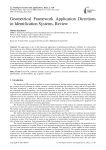
Geometrical Framework Application Directions in Identification Systems. Review
Статья научная
The approaches review of the framework application in identification problems is fulfilled. It is showed that this concept can have different interpretations of identification problems. In particular, the framework is understood as a frame, structure, system, platform, concept, and basis. Two directions of this concept application are allocated: 1) the framework integrating the number of methods, approaches or procedures; b) the mapping describing in the generalized view processes and properties in a system. We give the review of approaches that are the basis of the second direction. They are based on the analysis of virtual geometric structures. These mappings (frameworks) differ in the theory of chaos, accidents, and the qualitative theory of dynamic systems. Introduced mappings (frameworks) are not set a priori, and they are determined based of the experimental data processing. The main directions analysis of geometrical frameworks application is fulfilled in structural identification problems of systems. The review includes following directions: i) structural identification of nonlinear systems; ii) an estimation of Lyapunov exponents; iii) structural identifiability of nonlinear systems; iv) the system structure choice with lag variables; v) system attractor reconstruction.
Бесплатно
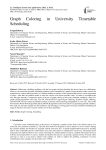
Graph Coloring in University Timetable Scheduling
Статья научная
Addressing scheduling problems with the best graph coloring algorithm has always been very challenging. However, the university timetable scheduling problem can be formulated as a graph coloring problem where courses are represented as vertices and the presence of common students or teachers of the corresponding courses can be represented as edges. After that, the problem stands to color the vertices with lowest possible colors. In order to accomplish this task, the paper presents a comparative study of the use of graph coloring in university timetable scheduling, where five graph coloring algorithms were used: First Fit, Welsh Powell, Largest Degree Ordering, Incidence Degree Ordering, and DSATUR. We have taken the Military Institute of Science and Technology, Bangladesh as a test case. The results show that the Welsh-Powell algorithm and the DSATUR algorithm are the most effective in generating optimal schedules. The study also provides insights into the limitations and advantages of using graph coloring in timetable scheduling and suggests directions for future research with the use of these algorithms.
Бесплатно
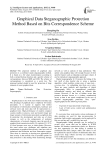
Graphical Data Steganographic Protection Method Based on Bits Correspondence Scheme
Статья научная
The proposed method of graphical data protection is a combined crypto-steganographic method. It is based on a bit values transformation according to both a certain Boolean function and a specific scheme of correspondence between MSB and LSB. The scheme of correspondence is considered as a secret key. The proposed method should be used for protection of large amounts of secret graphical data.
Бесплатно
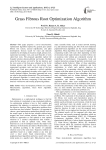
Grass Fibrous Root Optimization Algorithm
Статья научная
This paper proposes a novel meta-heuristic optimization algorithm inspired by general grass plants fibrous root system, asexual reproduction, and plant development. Grasses search for water and minerals randomly by developing its location, length, primary root, regenerated secondary roots, and small branches of roots called hair roots. The proposed algorithm explore the bounded solution domain globally and locally. Globally using the best grasses survived by the last iteration, and the root system of the best grass obtained so far by the iteration process and locally uses the primary roots, regenerated secondary roots and hair roots of the best global grass. Each grass represents a global candidate solution, while regenerated secondary roots stand for the locally obtained solution. Secondary generated hair roots are equal to the problem dimensions. The performance of the proposed algorithm is tested using seven standard benchmark test functions, comparing it with other meta-heuristic well-known and recently proposed algorithms.
Бесплатно

